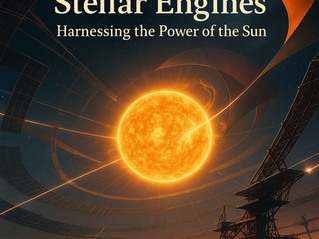Stellar Engines: Harnessing the Power of the Sun
- Mr_Solid.Liquid.Gas
- Oct 28
- 3 min read

What would it take for a civilization to tap directly into the output of a star—or even steer it across the galaxy?
Stellar engines occupy the boundary between hard physics and audacious engineering.
While they remain far beyond our present capabilities, thinking through their requirements sharpens our understanding of materials science, energy transfer, orbital dynamics, and long‑horizon ethics.
From swarms of light‑collecting satellites to megastructures that produce asymmetric radiation pressure, stellar engines are the ultimate thought experiment for a species learning to work with—not just around—cosmic forces.
Dyson Spheres and Swarms

Physicist Freeman Dyson popularized the idea that advanced civilizations might surround their star with collectors to harvest a significant fraction of its power output.
In practice, a rigid shell is impossible; tidal forces and material limits would tear it apart.
A more plausible architecture is a Dyson swarm: trillions of independent satellites in carefully managed orbits, each converting sunlight into useful work.
Such a swarm could beam power to habitats, fuel manufacturing, or drive spacecraft via laser or microwave propulsion.
Key challenges include orbital traffic management at unimaginable scale, waste‑heat rejection, and materials that endure constant radiation and micrometeoroid impacts.
Thermal control alone is non‑trivial: even with high conversion efficiency, a civilization must radiate vast amounts of heat to avoid destabilizing the swarm.
Still, incremental steps—large solar power constellations, power‑beaming experiments, and self‑replicating robotic assembly—map a path from today’s satellites to tomorrow’s megastructures.
Stellar Propulsion: Moving Entire Systems

A Shkadov thruster is the archetype of a stellar engine: a gigantic, semi‑reflective mirror placed near a star so that radiation pressure becomes slightly asymmetric.
The star emits the same total power, but more photons are redirected one way than the other, producing a minute net thrust that can, over millions of years, alter the star’s velocity.
In principle, this could steer an entire planetary system, avoiding future galactic hazards or optimizing long‑term trajectories.
Even if construction is feasible, stability is delicate.
The mirror must hold station against stellar gravity and radiation pressure while maintaining alignment.
Active control, orbital tethers, or swarms of coordinated reflectors could provide robustness: many small mirrors can fail gracefully where a single monolith cannot.
The timescales are epic, but so are the potential payoffs: system‑wide safety and a civilization‑scale navigation capability.
Material Science Challenges

Any structure operating near a star faces extremes of temperature, radiation, and particle flux.
Candidate materials include high‑temperature ceramics, refractory metal alloys, and carbon‑based composites with engineered emissivity.
Nanostructured coatings can tune absorptivity and reflectivity across bands, protecting surfaces from ultraviolet and particle erosion while optimizing energy capture.
Self‑healing materials and modular panel designs reduce maintenance burden.
Equally crucial is manufacturing at scale.
No civilization launches a Dyson swarm; it bootstraps one.
Asteroid‑sourced feedstocks, autonomous refineries, and in‑situ additive manufacturing would fabricate panels, trusses, and radiators in space.
The first factories build the second generation, compounding capacity until the project reaches an economy of scale.
Power‑beaming then closes the loop, energizing far‑flung construction sites beyond the inner system.
Energy Ethics: Cosmic Responsibility

A civilization capable of reshaping stellar energy flows also wields the power to alter planetary climates, biospheres, and night skies.
Who decides acceptable levels of sky brightness?
How are risks allocated among worlds that did not consent to engineering that affects their radiation environment?
Governance must evolve from ad‑hoc project management to intergenerational constitutional frameworks with transparency, oversight, and reversible design principles.
Ethical practice suggests incrementalism: begin with observational studies and small‑scale prototypes, conduct environmental impact assessments on planetary and cultural heritage, and ensure options for decommissioning.
The point is not to dominate the star, but to enter a long‑term, cautious relationship with it—one that centers stability, resilience, and shared benefit.
Conclusion

Stellar engines are more than sci‑fi eye candy; they’re rigorous prompts to test the limits of physics and policy.
By exploring Dyson swarms, Shkadov thrusters, and the materials and ethics they demand, we sketch a roadmap for energy systems that scale with civilization—without sacrificing the worlds that depend on them.
The Sun’s output is fixed; our wisdom in using it is not.
The future of stellar engineering will be written as much in law and culture as in mirrors and machines.




























